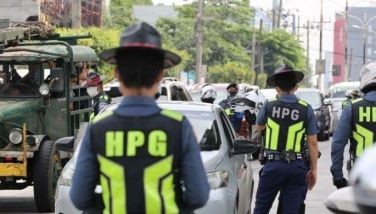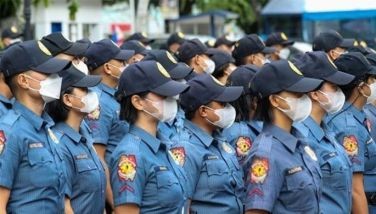Reyes orders update of geo-hazard maps
December 10, 2006 | 12:00am
Environment and Natural Resources Secretary Angelo Reyes ordered yesterday the immediate updating and upgrading of geo-hazard maps, particularly for disaster-prone regions of the country.
Reyes issued the order after he was informed that the geo-hazard mapping of the entire country at a scale of 1:250,000 was completed by the National Mapping and Resource Information Authority (NAMRIA), the Mines and Geosciences Bureau (MGB), Philippine Institute of Volcanology and Seismology (Phivolcs) and Philippine Atmospheric, Geophysical and Astronomical Services Administration (Pagasa).
More detailed maps drawn at a scale of 1:50,000, particularly for typhoon-prone areas, will be completed by the end of the year.
"The mudflows that affected several towns and villages along the slopes of Mt. Mayon in Albay is a most unfortunate incident," Reyes said.
He directed Department of Environment and Natural Resources (DENR) officials and employee in the Bicol region to provide immediate assistance to people affected by the mudflows.
Reyes recalled that in response to the Quezon and Leyte tragedies in 2004 and 2005, the government mobilized its various agencies to fast-track the preparation of geo-hazards maps to enable government agencies to immediately alert communities of possible natural hazards such as landslides, flooding, volcanic eruption, lahar flows, tsunamis, and typhoons.
Reyes was told that for this year, the 1:50,000 scale maps covering the eastern seaboard — a traditional typhoon belt area — may be finished by the end of this year.
Training sessions and workshops are also being conducted at the barangay level with the support of agencies of the United Nations and Australia.
The Bicol peninsula was mapped early this year and several seminars and workshops in barangays have been conducted, Reyes declared.
As for the areas around Mt. Mayon and Mt. Bulusan, NAMRIA and Phivolcs drew more detailed maps early this year due to the recent activities of the two volcanoes.
As early as June this year, several thousand people residing on the slopes of Mayon volcano were evacuated as a result of its intermittent eruptions. It was only early in October that residents were allowed to return to their homes.
Mayon’s eruptions earlier this year deposited millions of cubic meters of volcanic ash and rocks along its slope, most of it located near the peak and at higher elevations.
A Phivolcs report said typhoon "Reming" dumped 466 millimeters of rain, the heaviest single-day volume of rain since 1967. The unusual volume of rainfall loosened the accumulated ash and rocks, bringing them down to the flatlands and residential areas.
Lahar flows usually move eastward towards the Sto. Domingo town area, but this time floodwaters and mudflows moved towards the south and southwest, affecting the cities of Legaspi, Guinobatan, and Daraga, in addition to Sto. Domingo.
These recent experiences emphasize the fact that geo-hazard mapping, information dissemination and disaster preparedness is a continuing effort, Reyes said.
Reyes issued the order after he was informed that the geo-hazard mapping of the entire country at a scale of 1:250,000 was completed by the National Mapping and Resource Information Authority (NAMRIA), the Mines and Geosciences Bureau (MGB), Philippine Institute of Volcanology and Seismology (Phivolcs) and Philippine Atmospheric, Geophysical and Astronomical Services Administration (Pagasa).
More detailed maps drawn at a scale of 1:50,000, particularly for typhoon-prone areas, will be completed by the end of the year.
"The mudflows that affected several towns and villages along the slopes of Mt. Mayon in Albay is a most unfortunate incident," Reyes said.
He directed Department of Environment and Natural Resources (DENR) officials and employee in the Bicol region to provide immediate assistance to people affected by the mudflows.
Reyes recalled that in response to the Quezon and Leyte tragedies in 2004 and 2005, the government mobilized its various agencies to fast-track the preparation of geo-hazards maps to enable government agencies to immediately alert communities of possible natural hazards such as landslides, flooding, volcanic eruption, lahar flows, tsunamis, and typhoons.
Reyes was told that for this year, the 1:50,000 scale maps covering the eastern seaboard — a traditional typhoon belt area — may be finished by the end of this year.
Training sessions and workshops are also being conducted at the barangay level with the support of agencies of the United Nations and Australia.
The Bicol peninsula was mapped early this year and several seminars and workshops in barangays have been conducted, Reyes declared.
As for the areas around Mt. Mayon and Mt. Bulusan, NAMRIA and Phivolcs drew more detailed maps early this year due to the recent activities of the two volcanoes.
As early as June this year, several thousand people residing on the slopes of Mayon volcano were evacuated as a result of its intermittent eruptions. It was only early in October that residents were allowed to return to their homes.
Mayon’s eruptions earlier this year deposited millions of cubic meters of volcanic ash and rocks along its slope, most of it located near the peak and at higher elevations.
A Phivolcs report said typhoon "Reming" dumped 466 millimeters of rain, the heaviest single-day volume of rain since 1967. The unusual volume of rainfall loosened the accumulated ash and rocks, bringing them down to the flatlands and residential areas.
Lahar flows usually move eastward towards the Sto. Domingo town area, but this time floodwaters and mudflows moved towards the south and southwest, affecting the cities of Legaspi, Guinobatan, and Daraga, in addition to Sto. Domingo.
These recent experiences emphasize the fact that geo-hazard mapping, information dissemination and disaster preparedness is a continuing effort, Reyes said.
BrandSpace Articles
<
>
- Latest
- Trending
Trending
Latest
Trending
Latest
Recommended




























